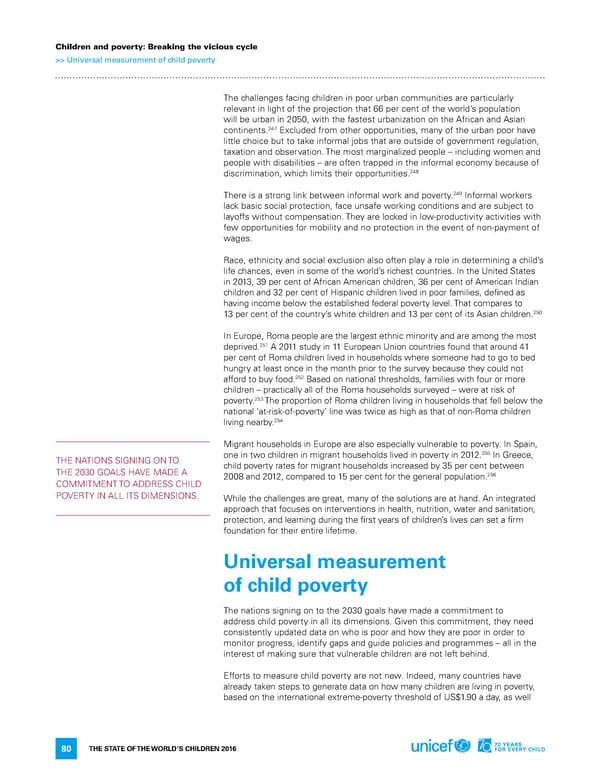Children and poverty: Breaking the vicious cycle >> Universal measurement of child poverty The challenges facing children in poor urban communities are particularly relevant in light of the projection that 66 per cent of the world’s population will be urban in 2050, with the fastest urbanization on the african and asian 247 continents. excluded from other opportunities, many of the urban poor have little choice but to take informal jobs that are outside of government regulation, taxation and observation. The most marginalized people – including women and people with disabilities – are often trapped in the informal economy because of 248 discrimination, which limits their opportunities. There is a strong link between informal work and poverty.249 informal workers lack basic social protection, face unsafe working conditions and are subject to layoffs without compensation. They are locked in low-productivity activities with few opportunities for mobility and no protection in the event of non-payment of wages. race, ethnicity and social exclusion also often play a role in determining a child’s life chances, even in some of the world’s richest countries. in the United States in 2013, 39 per cent of african american children, 36 per cent of american indian children and 32 per cent of hispanic children lived in poor families, defined as having income below the established federal poverty level. That compares to 13 per cent of the country’s white children and 13 per cent of its asian children.250 in europe, roma people are the largest ethnic minority and are among the most 251 deprived. a 2011 study in 11 european Union countries found that around 41 per cent of roma children lived in households where someone had to go to bed hungry at least once in the month prior to the survey because they could not 252 afford to buy food. Based on national thresholds, families with four or more children – practically all of the roma households surveyed – were at risk of 253 poverty. The proportion of roma children living in households that fell below the national ‘at-risk-of-poverty’ line was twice as high as that of non-roma children 254 living nearby. Migrant households in europe are also especially vulnerable to poverty. in Spain, one in two children in migrant households lived in poverty in 2012.255 The naTionS SiGninG on To in Greece, The 2030 GoalS haVe Made a child poverty rates for migrant households increased by 35 per cent between 2008 and 2012, compared to 15 per cent for the general population.256 CoMMiTMenT To addreSS Child PoVerTY in all iTS diMenSionS. While the challenges are great, many of the solutions are at hand. an integrated approach that focuses on interventions in health, nutrition, water and sanitation, protection, and learning during the first years of children’s lives can set a firm foundation for their entire lifetime. Universal measurement of child poverty The nations signing on to the 2030 goals have made a commitment to address child poverty in all its dimensions. Given this commitment, they need consistently updated data on who is poor and how they are poor in order to monitor progress, identify gaps and guide policies and programmes – all in the interest of making sure that vulnerable children are not left behind. efforts to measure child poverty are not new. indeed, many countries have already taken steps to generate data on how many children are living in poverty, based on the international extreme-poverty threshold of US$1.90 a day, as well The STaTe of The World’S Children 2016 80
 70 Years for Every Child Page 96 Page 98
70 Years for Every Child Page 96 Page 98